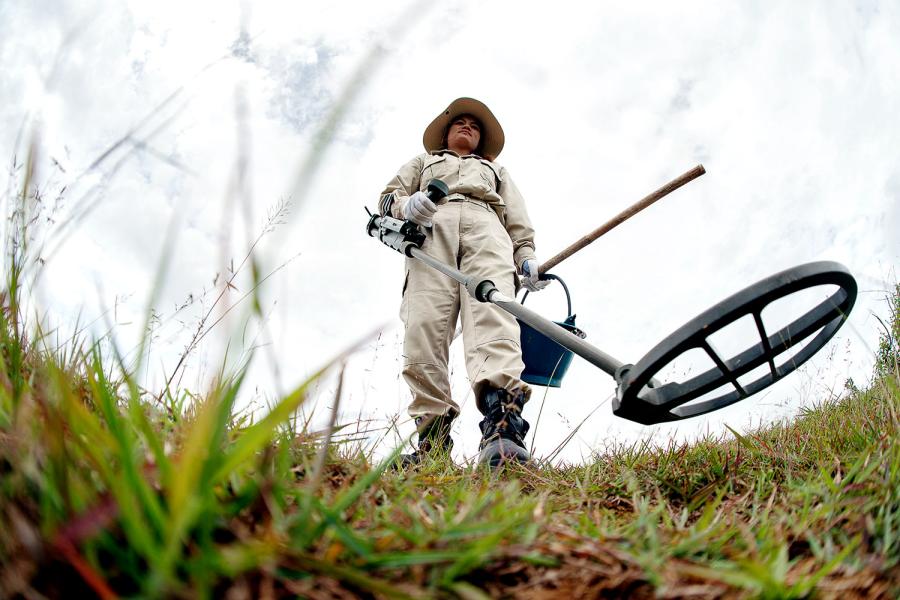Unexploded Ordnance, an Obstacle to Development
04 April 2018
- How graduation from Least Developed Country status is linked to Lao PDR’s war legacy.

Lao PDR has just recently fulfilled, for the first time, the eligibility criteria to graduate from Least Developed Country (LDC) status. It has passed two of the three criteria for graduation: Gross National Income per capita and the Human Assets Index, and has come close to passing the threshold for the Economic Vulnerability Index. This is a remarkable achievement which predicts a bright future for the country and its people – but, at the same time, it is by no means a time to lean back and rest. The level of development needs to be sustained in the coming years for graduation to happen.
The LDC graduation criteria are linked to a significant obstacle to Lao PDR’s development: unexploded ordnance (UXO). Many of the bombs that were dropped on Lao PDR decades ago still lie in the ground, active and treacherous.
The majority of Lao PDR’s communities rely on agriculture for a living. But in areas where UXO contamination is prevalent, fear rules the fields, hindering farmers to grow food for their families, unable to escape the poverty trap.
UXO has a direct impact on the economy of the country, as contaminated land could otherwise be used for the development of industry, tourism and the construction of infrastructure. Victims of UXO accidents are facing serious obstacles to access the labour market as there is no network of special programs to allow them to contribute to the GDP. Transporting goods and services in contaminated areas adds to the challenge.
Children – the most valuable asset Lao PDR has for the future – are at risk, playing in areas not yet cleared or foraging in the forest. Children disabled by UXO drop out of school because of lacking infrastructure, emotional stress and not least, social stigma. Schools and roads cannot be built because of the bombs hindering construction.
Looking for solutions and innovative approaches to solve the UXO problem is a continued effort in the country: The Government set up UXO Lao, the national clearance operator in 1996, and established the coordinating body for the UXO sector, the National Regulatory Authority for UXO and Mine Action (NRA) in 2006. The technical skills of both organizations have increased significantly over the past years.
Various important policies, and documents were developed to coordinate the work of the UXO sector, including the national strategy plan for the UXO Sector in Lao PDR, entitled “Safe Path Forward II”. Lao PDR has launched a dedicated national Sustainable Development Goal, SDG 18 “Lives safe from UXO.”
Positive changes were seen in recent years thanks to the evidence-based survey approach now used by all operators to clear the land, which increased the amount of UXO found per hectare of land by more than four times, and allowed clearance to happen much faster. The surveys have resulted in more than 60,000 hectares of confirmed hazardous areas identified since 2015.
The number of UXO casualties has been reduced by 85 per cent over the last decade. In recent years, less than 50 casualties have been reported annually, below the national target of less than 75 casualties a year. In 2017, the number of accidents was almost a tenth of what it was in 2008: 19 accidents. This is the second lowest number of accidents in the past decade. The 19 accidents resulted in 41 casualties, the lowest number since the war.
Risk education messaging is reaching farther and wider than ever before. Via textbooks and radio messages, children and adults learn how to live with the hazard of UXO. In 2017 alone, more than 250,000 people in 516 villages, half of whom were children, were reached by such risk awareness activities, including puppet shows, songs, and games. Even broader risk education through school curricula and radio programs is required, along with targeted interventions in the most contaminated villages.
With the introduction of the SDG18, the aim is to balance its three targets on mine risk education, victim assistance and clearance. Focusing on one of the three alone is not enough in order to ensure that by 2030, these SDG 18 targets are met and the impact of UXO in Lao PDR is reduced, making lives safe from the threat of UXO.
In this regard, the Government and the UNDP in Lao PDR will continue to cooperate in order to reduce the impact of UXO on the country and ensure a smooth LDC graduation process.


